Starting a new job can be challenging, especially when it comes to meeting new colleagues and building rapport quickly. One way to ease this transition is by sending a self-introduction email. In this article, you'll discover the essentials of writing an effective introductory email and find helpful tips for maintaining proper email etiquette.
In addition, we provide free samples of self-introduction emails to help you structure your own email with ease. Without further ado, let’s get started.

(Source: Stripo email template)
What is an introduction email?
Starting a new job is an exciting opportunity, and introducing yourself to your colleagues is a great way to kick things off. Sending a self-introduction email enables you to convey your enthusiasm and eagerness to connect with your new team. In this email, you can share details about your professional background, explain your role, and suggest meeting for coffee or lunch to get to know each other better. This simple gesture can help you create valuable connections and build a strong foundation for your time with the company.
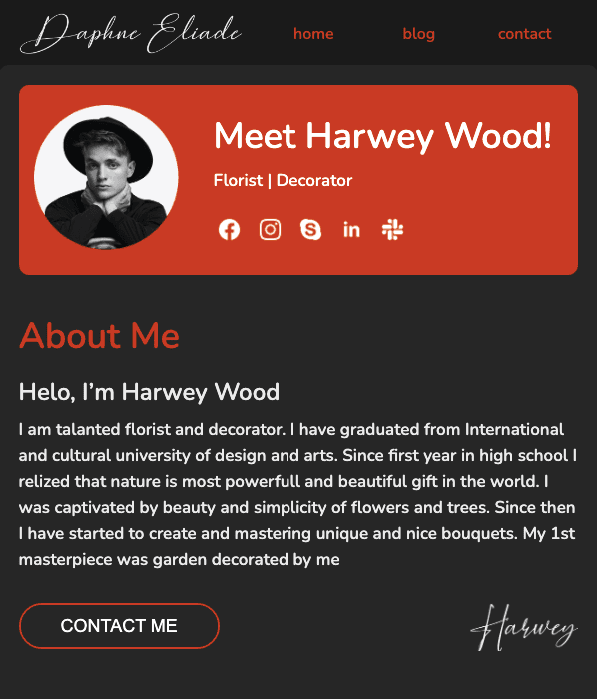
(Source: Stripo email template)
Why should you write introduction emails?
The older people become, the harder it is for them to create new connections. And you are not the only one who might be afraid of meeting new people. Nevertheless, it's essential to formally introduce yourself and create mutual contact with your team as a part of corporate culture.
Moreover, a friendly and enthusiastic introduction can significantly ease your onboarding process. When your new team sees your positive attitude, they are likely to respond in kind, helping you integrate smoothly and become productive more quickly. Here are a few more reasons why you should create introduction emails to send to your new team.
This is your chance to professionally introduce yourself
As you know, first impressions can be wrong, especially if you aren't able to meet your colleagues in person. That's the reason why you should use the opportunity to share something about yourself and show your genuine desire to connect.
You let your new colleagues know what your duties will be
Use this opportunity to share some additional information about yourself, mention your position, briefly describe your responsibilities, and share your contact details so that you can connect in person.
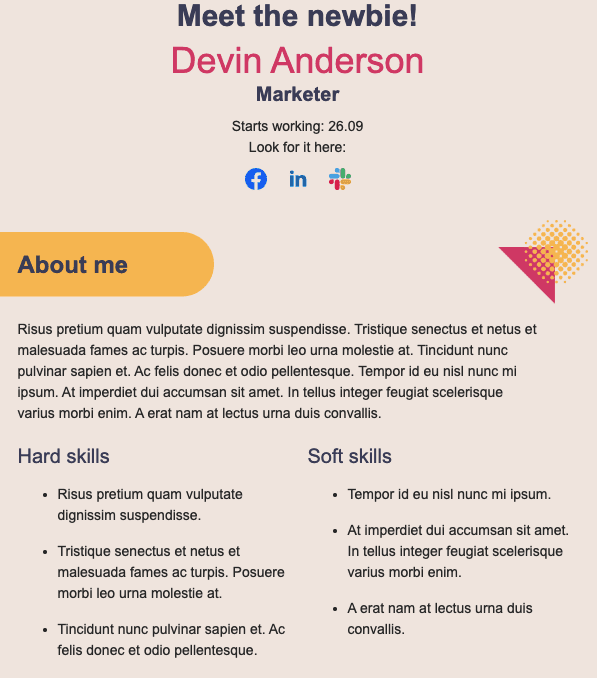
(Source: Stripo email template)
It encourages and enhances further communication with team members
Understanding the new team member's background, role, and responsibilities can significantly improve communication within the team. An introduction email provides essential context for their interactions with existing team members, fostering better collaboration and integration.
What to include in your introduction email
Here are a few bullet points to check and make sure your introductory email looks good to any recipient:
Tip #1. Come up with a clear subject line
Subject lines are one of the most important parts of your email, as 64% of recipients decide to open or delete emails based on subject lines. Nowadays, when our inboxes are deluged with dozens of emails, no one will want to open an email without an appealing subject line.
Depending on the corporate culture of the company, you may choose the most suitable tone for your message. The subject line should also be appropriate to your position. Make sure you include your job title in your email subject line, as your coworkers may regard an email from an address they don't recognize as suspicious.
Examples of subject lines
Take these subject lines as an example for your introductory email subject line:
- "Hello" from a new account manager.
- New employee introduction email from Alan Brown.
- Let's get acquainted — meet a new employee.
- Let’s get started!
- Meeting my new team.
- A bit about myself.
- Greetings from John Doe!
- Just started with [Company name], and I’d love to get introduced!
- Introduction from the new [Job position] at [Company name].
- Hi [Recipient name], I’m [Your name] – the new [Job position].
Tip #2. Choose a proper friendly greeting
Formal greeting or a friendly hello?
Rely on your common sense when choosing how to write your introduction email. Check the tone that is generally used in the company's communications. To be absolutely sure, you may discuss the message with an HR manager or your supervisor.
Anyway, you should keep things professional, even if you write in a friendly manner.
Tip #3. Mention the reason why you are writing your introduction email
Ideally, the purpose of your introduction email should be understood from its subject line. However, sometimes a few words in a subject line are not enough.
In the first line of your email, you should simply mention that you have recently joined the team and that you would like to introduce yourself. You could perhaps add that you are open to new connections and you are looking forward to meeting your coworkers.
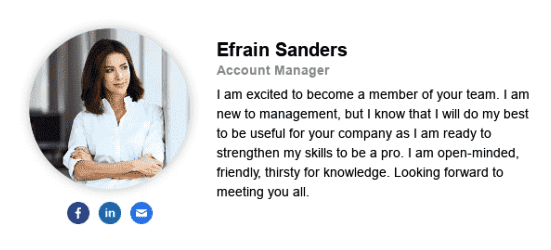
(Source: Stripo email template)
Tip #4. Describe your previous work experience and new responsibilities
The best way to establish a new contact is to let people know what they can approach you with. Say a few things about your professional background and explain why it will be useful at this company.

(Source: Stripo email template)
Also, provide a short overview of your new job and main responsibilities for your coworkers from other departments. If you are going to manage a team, let them know you are their new supervisor in your email introduction.
Tip #5. Express your genuine interest and excitement
Feel free to show a few of your emotions in the professional introduction email. People appreciate openness and they will probably share your enthusiasm if you are sincere.
It is also appropriate to write that you are looking forward to meeting your colleagues in person (if it is an option), or at least that you hope to contact them by video call.
Tip #6. Reply to all emails from new colleagues you receive
Of course, your coworkers may reply to your new employee introduction email. Feel free to respond to their message, as this may help you build and strengthen contact.
In addition, you will have a starting point for a conversation with that person later. Why miss the opportunity?
Things to consider when writing a professional introduction emails
You have already been introduced to the essentials of a good self-introduction email. Let's have a closer look at the details that will make your appearance at the company more remarkable.
Tip #1. Prepare a self introduction email template
Sometimes emotions overwhelm us, and we tend to forget everything. This might be inconvenient when writing a professional email introduction.
We recommend that you write a business introduction email template beforehand, with a clear mind. You could consider sharing it with some of your friends for their advice on what you should add or remove. Such email examples can be universal and used for different purposes.
However, the above does not apply to superstitious people :).
Tip #2. Proofread your introduction emails
Proofreading is undoubtedly a "must" for all emails. It's crucial to avoid mistakes in a self-introduction email, because it will create the recipient’s first impression of your personality. And first impressions mean everything when it comes to a new job.
A spell check is essential — make sure that the company name and the recipient’s name are written correctly.
Grammar can also be a pain point, especially for non-native speakers. Luckily, there are plenty of tools that help you with writing professional emails.
And last but not least, double-check any attachments and links that appear in your self-introduction email. You wouldn't want your new coworkers to discover your secrets on the first day, would you?
Tip #3. Start with an eye-catching subject line
As touched on earlier, it's hard to overestimate the importance of a subject line in an introduction email.
Not only should the subject line be brief and accurate, but you should ensure that its fits the inbox preview line. Otherwise, the important part may not be visible to the recipient.
Also, there's no need to duplicate your name in a subject line if it's stated clearly in your email account — it would be better to mention the position or use a fun intro.
Tip #4. Keep your email concise and structured
A perfect self-introduction email should include a polite greeting, a genuine opening statement, a concise summary of your professional background, an expression of interest in meeting your new colleagues, and your contact information. Following this structure and keeping it brief will help you make a strong and positive first impression.
Tip #5. Use an organizational chart to get to know your new colleagues
Most companies have their organizational charts, which may help you to get to know the names, positions, and contacts of the main team leaders. You may find this information on the company site, or HR managers can email it to you on your first working day.
You can use the organizational chart to make sure you send your introduction email to everyone you will be working with. Also, you could mention in your message that you would be pleased to come to their office to meet face to face.
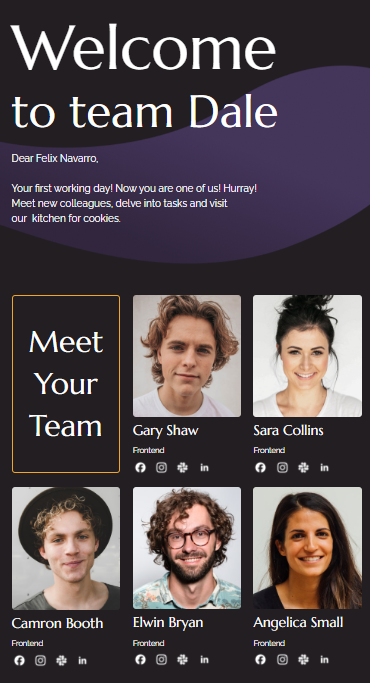
(Source: Stripo email template)
Tip #6. Implement useful phrases in your introduction email templates
Facing writer’s block? Here are some helpful phrases for crafting a warm, succinct, and effective self-introduction email to your new team.
"Please don't hesitate to reach out if you have any questions about my role at [Company]."
This phrase helps your colleagues understand that you're open to clarifying your responsibilities, ensuring everyone is on the same page.
"Thank you for taking the time to read my introduction."
Expressing gratitude demonstrates that you value their time and attention, setting a positive tone for future interactions.
"I'd love to schedule a call to discuss how we can best collaborate."
Proposing a call provides an opportunity for a more personal connection, allowing you to discuss your upcoming work and gather valuable insights about the company.
Tip #7. Use an appropriate ending for your introduction email
When wrapping up a self-introduction email, it's crucial to maintain consistency in tone. If your email has been warm and personable, ending with a formal sign-off might feel out of place.
Selecting the right closing depends on the level of formality you want to convey. "Sincerely" is a reliable choice for formal communication. "Best regards" offers a middle ground, blending professionalism with a touch of friendliness. For a more casual and approachable feel, "Best" is concise and modern.
Incorporating phrases such as "looking forward to meeting you" or "thanks in advance" before your sign-off can add a personal touch. "Looking forward to meeting you" expresses enthusiasm for future interactions, while "thanks in advance" shows appreciation for any forthcoming assistance or responses.
What you should not include in your introduction emails
Tip #1. Don't be too personal in your professional introduction email
It’s best not to provide links to your social media accounts or attach photos of your family — email introductions should remain formal.
Try to be as work-related as possible. However, feel free to share your professional achievements or hobbies to help people get to know you better.
Tip #2. Avoid chat language or professional slang for an effective introduction
Even if the company's corporate culture allows you to communicate in a friendly manner, you shouldn't use chat language for your introduction email. Maintain a formal tone until you are absolutely sure it's appropriate to use something more casual.
Professional slang, on the other hand, could make you appear boring or even flaunting. In fact, people tend not to use many "difficult" terms in their professional environment because they will be just as well understood using simple words.
Tip #3. Don’t turn your self-introductions into longreads
It would be great if you could master the art of being somewhat intriguing when writing an introduction email. There's no need to rewrite your entire CV in the introduction letter.
Mention a few essential details about yourself, but don't reveal all your cards; leave some space for a short talk in the future.
Your self-introduction email should spark the interest of your coworkers and generate a desire to get to know you better!
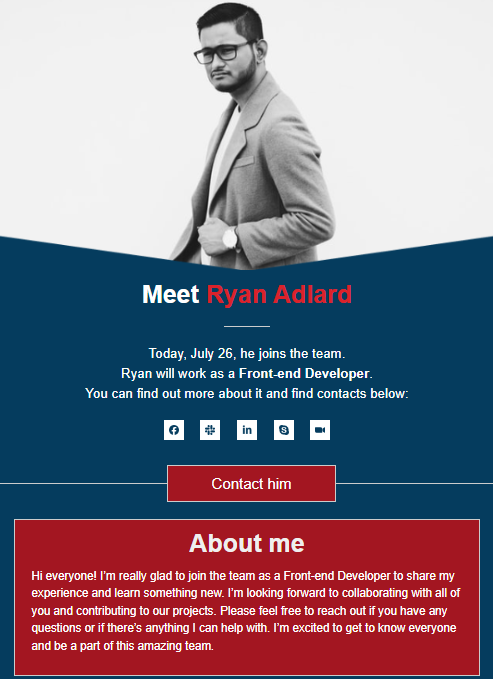
(Source: Stripo email template)
Tip #4. Avoid highlighting that you are new in your self-introductions
In your introduction email, steer clear of mentioning that you're new to the recipient. Phrases such as "We haven't met" or "You might not know me" can create a sense of distance and caution. Instead, approach the conversation with warmth and confidence, as if you’re already acquainted, to foster a sense of familiarity and build trust.
Introduction email examples
1. Template from the new team member.
Email subject line: A Quick Hello from Nick Dyson, the new Account Manager
Hello everyone,
I hope your week is going smoothly!
My name is Nick – I have recently joined the [company name] and I am excited to become a part of the team. I am writing this introduction email to let you know a bit more about myself.
As the new Account Manager, I will be taking over [projects and tasks]. You may contact me in case you need to discuss some of the services we may provide to the new clients.
A few things about me: I studied at [university name], was an intern at [company name], and I worked as a [job title] for [company name] for two years before coming here. While I was applying for this role, I noticed [key advantages of the business], which made me interested in the industry. I believe my experience will be useful when it comes to improving [product].
If you have any questions, feel free to contact me directly. Also, please let me know if there is anything I can help you with.
I am looking forward to meeting in person and getting to know each other better.
Best,
Nick Dyson
2. Formal introduction email to send to the manager.
Email subject line: Introduction email from [Name], the new PM
Good morning [recipient name],
I hope this email finds you well!
My name is [Name] and I am the new Project Manager at [project name]. I am writing to formally introduce myself and get acquainted.
I have had previous experience of working with [tasks, processes, clients], which I believe will help me to become a good fit for the company.
I am very excited to join the company and I would really appreciate it if we could meet in person. [Company name] amazes with its company culture, including the onboarding process.
I am starting on the [start date] and I will be taking over [tasks]. Please feel free to contact me in order to discuss any of these tasks.
Thank you for your time and attention.
Kind regards,
Allison Nate
3. Introduction email to send if you're a new manager
Email subject line: Brief introduction from the new [role]
Dear team,
My name is Nicolas Dayton and I am excited to introduce myself as your new [Head of a department]. My first day will be on the [start date]. We will have a general meeting then, so you will get an opportunity to meet me in person pretty soon.
I am happy to join the company, as I do appreciate its [product, social initiative, corporate culture, position on the market, etc.]
My experience includes [projects, achievements, managerial results], which served as a great starting point for me. My team managed to [improve business in this and that way], which helped us to obtain many prospective clients. I believe we can implement plenty of updates to make our work more efficient and the product more outstanding on the market.
As the [Head of the department] I am planning to [do some essential changes].
In the first two weeks, I would like to meet everyone to get to know more about the team and the personal contributions of each team member. I am looking forward to that!
Don't hesitate to contact me if you want to discuss anything or suggest something that may improve our business processes.
Let's make our collaboration successful and achieve better results together!
Best regards,
Nicolas Dayton
4. Introduction email to other department lead
Email subject line: Greetings from [Company name] new Senior Editor
Hi Alex,
I hope this email finds you well. My name is Jill Harris, and I have recently joined Acme Marketing as the new Senior Editor. Previously, I held a similar role at Example SaaS, and I'm excited to bring my experience to the team here at Acme.
Given your role as Head of Marketing, I wanted to introduce myself since we'll be collaborating closely. I’ve been following your impressive achievements, particularly the outstanding results you achieved last quarter. Your strategic use of the content department to drive organic leads was truly inspiring.
As I settle into my new role, I’d love to schedule a video call to get to know each other and discuss our upcoming projects. If you have any questions or would like to chat about my vision for Acme’s content strategy, please feel free to reach out.
Looking forward to working together,
Best regards,
Jill Harris
Wrapping up
As you can see, introduction emails are essential in professional communication. And they are not that easy to write, frankly speaking. However, the process will be much easier if you keep in mind the most important tips we have discussed above. Let's recap briefly.
- Make sure your subject line is brief and informative. Include your name and position to keep it specific and topical.
- Pay attention to the tone of your message. Remind yourself of the communication during the hiring process, and check the company's social media or website to verify you’re on the right track.
- The first line is for explaining the reason why you're reaching out. People tend not to waste their time on unnecessary emails, and you need to clarify the purpose of your email to focus their attention.
- Be sincere. It's important to express your emotions to show that you are also a human being and that you're happy to join the team. Even if you feel nervous, it's perfectly fine to mention it.
- Get ready to chat. While it’s less likely, your coworkers may reply to your introduction email to establish contact and congratulate you on the new job. Feel free to respond to them directly and maybe even invite them to grab a coffee.
- Send different emails to the team and management. It’s advisable to send separate emails to different categories of people. You can personalize your emails and find the perfect language to achieve your aim.
- Don't forget the double-check. We all make mistakes, especially when an emotional element is present (and a new job is always about emotions). Check your spelling, make sure you write names correctly to avoid being embarrassed, and ask a friend or colleague to proofread the email using Grammar checker.
- Keep your message laconic. Leave long stories for the future and mention only the key information that will help the team get a general idea of your personality.
- Express enthusiasm. You should be enthusiastic in your emails, so that your colleagues will want to meet you. Remain positive, say a few words about how you like to spend your spare time, and there will definitely be someone who would like to get to know you better.
- Prepare templates today, and say "thank you" to yourself tomorrow. No one likes preparing templates when you send such emails once in a while. However, we can assure you that using a template for an introduction email can be as useful as a CV prepared beforehand. Take your time, think about what you would like to share when introducing yourself to your new colleagues, or ask some friends and at least write an abstract. You may also find the above suggestions helpful when writing a covering email for a job application.





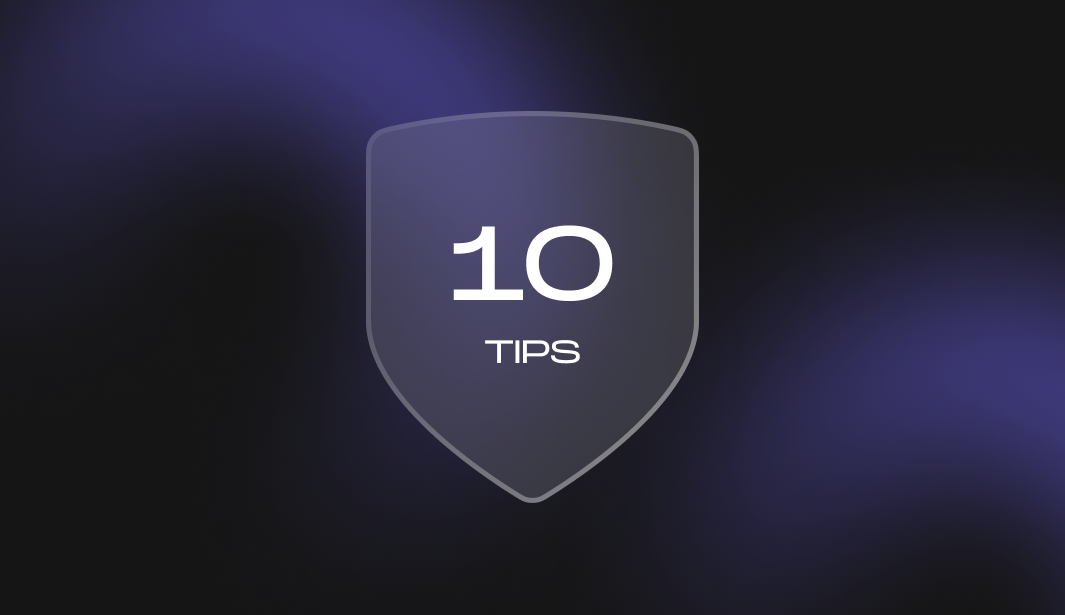

0 comments